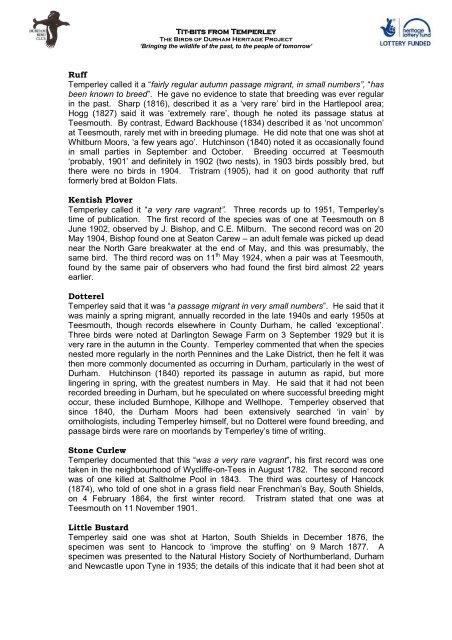'Tit-bits from Temperley' - Durham Bird Club
'Tit-bits from Temperley' - Durham Bird Club
'Tit-bits from Temperley' - Durham Bird Club
You also want an ePaper? Increase the reach of your titles
YUMPU automatically turns print PDFs into web optimized ePapers that Google loves.
Tit-<strong>bits</strong> <strong>from</strong> Temperley<br />
The <strong>Bird</strong>s of <strong>Durham</strong> Heritage Project<br />
‘Bringing the wildlife of the past, to the people of tomorrow’<br />
Ruff<br />
Temperley called it a “fairly regular autumn passage migrant, in small numbers”, “has<br />
been known to breed”. He gave no evidence to state that breeding was ever regular<br />
in the past. Sharp (1816), described it as a „very rare‟ bird in the Hartlepool area;<br />
Hogg (1827) said it was „extremely rare‟, though he noted its passage status at<br />
Teesmouth. By contrast, Edward Backhouse (1834) described it as „not uncommon‟<br />
at Teesmouth, rarely met with in breeding plumage. He did note that one was shot at<br />
Whitburn Moors, „a few years ago‟. Hutchinson (1840) noted it as occasionally found<br />
in small parties in September and October. Breeding occurred at Teesmouth<br />
„probably, 1901‟ and definitely in 1902 (two nests), in 1903 birds possibly bred, but<br />
there were no birds in 1904. Tristram (1905), had it on good authority that ruff<br />
formerly bred at Boldon Flats.<br />
Kentish Plover<br />
Temperley called it “a very rare vagrant”. Three records up to 1951, Temperley‟s<br />
time of publication. The first record of the species was of one at Teesmouth on 8<br />
June 1902, observed by J. Bishop, and C.E. Milburn. The second record was on 20<br />
May 1904, Bishop found one at Seaton Carew – an adult female was picked up dead<br />
near the North Gare breakwater at the end of May, and this was presumably, the<br />
same bird. The third record was on 11 th May 1924, when a pair was at Teesmouth,<br />
found by the same pair of observers who had found the first bird almost 22 years<br />
earlier.<br />
Dotterel<br />
Temperley said that it was “a passage migrant in very small numbers”. He said that it<br />
was mainly a spring migrant, annually recorded in the late 1940s and early 1950s at<br />
Teesmouth, though records elsewhere in County <strong>Durham</strong>, he called „exceptional‟.<br />
Three birds were noted at Darlington Sewage Farm on 3 September 1929 but it is<br />
very rare in the autumn in the County. Temperley commented that when the species<br />
nested more regularly in the north Pennines and the Lake District, then he felt it was<br />
then more commonly documented as occurring in <strong>Durham</strong>, particularly in the west of<br />
<strong>Durham</strong>. Hutchinson (1840) reported its passage in autumn as rapid, but more<br />
lingering in spring, with the greatest numbers in May. He said that it had not been<br />
recorded breeding in <strong>Durham</strong>, but he speculated on where successful breeding might<br />
occur, these included Burnhope, Killhope and Wellhope. Temperley observed that<br />
since 1840, the <strong>Durham</strong> Moors had been extensively searched „in vain‟ by<br />
ornithologists, including Temperley himself, but no Dotterel were found breeding, and<br />
passage birds were rare on moorlands by Temperley‟s time of writing.<br />
Stone Curlew<br />
Temperley documented that this “was a very rare vagrant”, his first record was one<br />
taken in the neighbourhood of Wycliffe-on-Tees in August 1782. The second record<br />
was of one killed at Saltholme Pool in 1843. The third was courtesy of Hancock<br />
(1874), who told of one shot in a grass field near Frenchman‟s Bay, South Shields,<br />
on 4 February 1864, the first winter record. Tristram stated that one was at<br />
Teesmouth on 11 November 1901.<br />
Little Bustard<br />
Temperley said one was shot at Harton, South Shields in December 1876, the<br />
specimen was sent to Hancock to „improve the stuffing‟ on 9 March 1877. A<br />
specimen was presented to the Natural History Society of Northumberland, <strong>Durham</strong><br />
and Newcastle upon Tyne in 1935; the details of this indicate that it had been shot at


